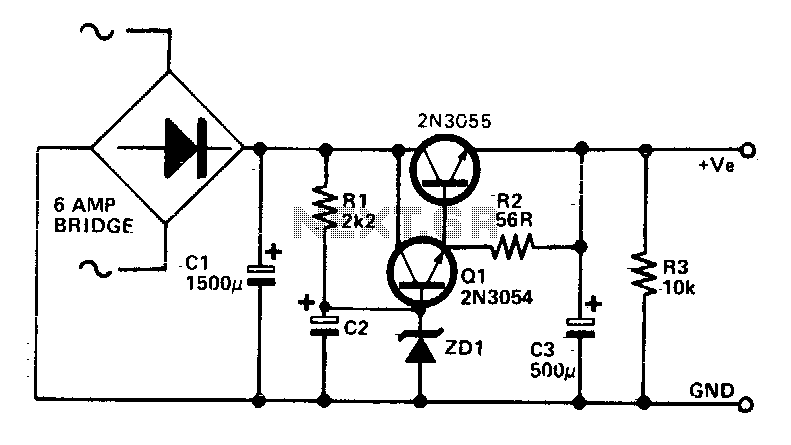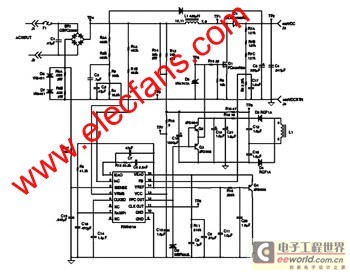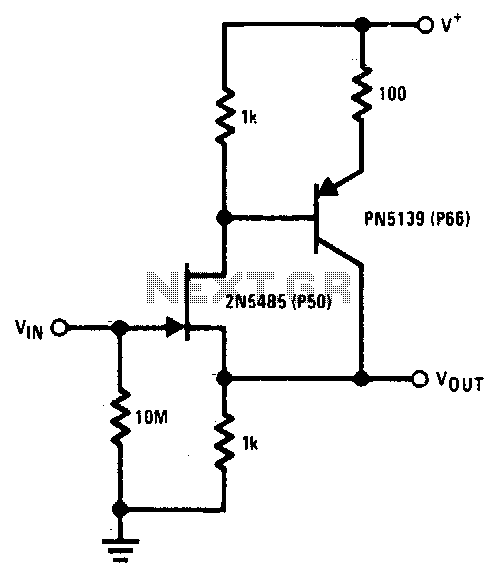
Low ripple power supply

This circuit can be utilized in applications requiring high current with low ripple voltage, such as in high-powered Class AB amplifiers where high-quality audio reproduction is essential. Q1, Q2, and R2 can be considered as a power Darlington transistor configuration. ZD1 and R1 establish a reference voltage at the base of Q1, with ZD1 selected according to the formula: ZD1 = Von - 1. Additionally, the capacitor C2 can be selected based on the desired level of smoothness, as its effective capacitance is multiplied by the combined gains of Q1 and Q2. For instance, if a value of 100 µF is chosen for C2, with the minimum hfe values for Q1 and Q2, the effective capacitance can be calculated as C = 100 x 15 (Q1) x 25 (Q2) = 37,000 µF.
The described circuit is designed to meet the demands of high current applications while ensuring minimal ripple voltage, which is crucial for the fidelity of audio signals in Class AB amplifiers. The Darlington transistor configuration formed by Q1 and Q2 provides high current gain, allowing the circuit to drive larger loads efficiently. The selection of ZD1 is critical; it should be set to provide a stable reference voltage that compensates for the base-emitter voltage drop of Q1, ensuring proper biasing of the transistor.
R1 works in conjunction with ZD1 to set the desired operating point of Q1, influencing the overall performance of the amplifier. The choice of C2 is particularly important as it directly affects the output ripple voltage. By selecting a larger capacitance value, the circuit can achieve smoother output by effectively filtering out fluctuations in voltage. The calculated effective capacitance of 37,000 µF, when using a 100 µF capacitor for C2, illustrates the significant impact of the transistor gains on the overall capacitance, providing a robust solution for high-performance audio applications.
In summary, this circuit design is well-suited for high-current, low-ripple voltage applications, particularly in audio amplification, where sound quality is paramount. The careful selection of components, especially the reference voltage and capacitance, plays a vital role in ensuring optimal performance and reliability of the amplifier.This circuit may be used where a high current is required with a low ripple voltage (such as in a high powered class AB amplifier when high quality reproduction is necessary), Ql, Q2, and R2 may be regarded as a power darlington transistor. ZDl and Rl provide a reference voltage at the base of Ql. ZDl should be chosen thus: ZDl = Von-1 C2 can be chosen for the degree of smoothness as its value is effectively multiplied by the combined gains of Q1/Q2, if 100 µF is chosen for C2, assuming minimum hfe for Ql and Q2, C = 100 x 15(Q1) x 25(Q2) = 37,000 µf.
The described circuit is designed to meet the demands of high current applications while ensuring minimal ripple voltage, which is crucial for the fidelity of audio signals in Class AB amplifiers. The Darlington transistor configuration formed by Q1 and Q2 provides high current gain, allowing the circuit to drive larger loads efficiently. The selection of ZD1 is critical; it should be set to provide a stable reference voltage that compensates for the base-emitter voltage drop of Q1, ensuring proper biasing of the transistor.
R1 works in conjunction with ZD1 to set the desired operating point of Q1, influencing the overall performance of the amplifier. The choice of C2 is particularly important as it directly affects the output ripple voltage. By selecting a larger capacitance value, the circuit can achieve smoother output by effectively filtering out fluctuations in voltage. The calculated effective capacitance of 37,000 µF, when using a 100 µF capacitor for C2, illustrates the significant impact of the transistor gains on the overall capacitance, providing a robust solution for high-performance audio applications.
In summary, this circuit design is well-suited for high-current, low-ripple voltage applications, particularly in audio amplification, where sound quality is paramount. The careful selection of components, especially the reference voltage and capacitance, plays a vital role in ensuring optimal performance and reliability of the amplifier.This circuit may be used where a high current is required with a low ripple voltage (such as in a high powered class AB amplifier when high quality reproduction is necessary), Ql, Q2, and R2 may be regarded as a power darlington transistor. ZDl and Rl provide a reference voltage at the base of Ql. ZDl should be chosen thus: ZDl = Von-1 C2 can be chosen for the degree of smoothness as its value is effectively multiplied by the combined gains of Q1/Q2, if 100 µF is chosen for C2, assuming minimum hfe for Ql and Q2, C = 100 x 15(Q1) x 25(Q2) = 37,000 µf.





